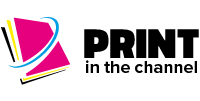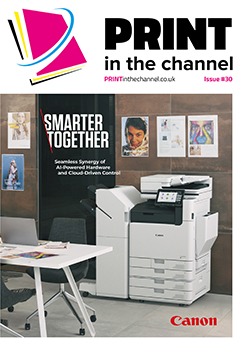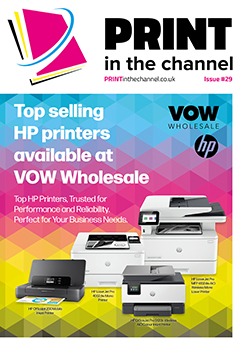Colin Bosher has been a technology innovator within the office automation, print, and fintec/XaaS sector for more than 30 years. However, his desire is to continue pushing the boundaries of innovation, shows no sign of diminishing just yet.
EKM Global has a reputation for being an industry pioneer, and it is something that company founder places great emphasis on; Colin always seeks to be ahead of the competition by relentlessly developing innovative products, solutions, and services that proactively address gaps in the market, whilst also fulfilling specific customer requirements.
Often shaped by historical trend data, logical creativity is part of Colin’s DNA – and it is something he has delivered consistently for more than 30 years. Although his story could have been quite different; he started out as a financial consultant with Cowie Interleasing in the late 1980s – and was successful at it – so much so that an Interleasing customer offered him a role in their company. It was that moment that his journey in the print channel and technology industry began.
“We are increasingly developing subscription programmes with integrated remote monitoring and management for a growing range of OEMS so they can easily incorporate everything onto contract – not just printing and imaging, but everything-as-a-Service positioned to their customers as a low-cost monthly subscription.
“I initially worked with a technology company called Misys Group, where after selling them a fleet of new vehicles they offered me a job!” he recalls. He was installed in their industry specialist VAD, Zygal Dynamics who as a subsidiary company were primarily a distributor for Fujitsu selling dot-matrix, system and line printers, as well as the first laser printers from Canon, HP, and Kyocera.
“I worked for them for five years, building up a considerable business selling into the channel,” he says. “It was incredibly profitable; we were packaging up pallets every Monday morning and shipping them out to various vertical market system VARs.”
From there, he moved to Kyocera. This was at the dawn of ECOSys and the total cost of ownership concept, where Colin was creating some of the first audit assessments for businesses to help migrate from products that were expensive to run. “We sold thousands of devices into corporates off the back of the total cost of ownership approach, making significant savings for those organisations,” he says.
Later, Colin put together the first cost per page ‘Print-Plan’ for Cornerstone Estate Agents via Copymore (acquired by IKON ahead of Ricoh), which had about 400 branches. “It worked really well, there was healthy profit in it for our reseller, where the deal was capitalised up front, which made it easier to deploy from a commercial perspective,” he says.
After further success in that space, Colin went onto work for HP as the company’s first Hard Copy specialist ahead of taking on the role of global program director based in Bergamo in Italy, where he was responsible for developing relevant packaged solutions to accelerate the adoption of breakthrough technologies across the two-tier channel.
“We had the first Digital Sender device, which was powerful enough to support up to 5,000 integrated applications, and could support 100,000 user address book,” he says. “It looked like an expensive fax machine, although the most successful engagement model was to apply and application centric approach to support technology & workflow optimisation. This was achieved by ensuring seamless integration into core client infrastructures that enabled users to share documents more easily via the network, and specific document processing applications, which further accelerated the industry migration from hard to soft copy document distribution shifting to scan > distribute > archive – print on demand/as required.”
In parallel, Colin was also asked to join the global strategic win team for HP working with key stakeholders who were directly led by CEO Carly Fiorina and her husband Frank, working out of Reston, Washington. He then moved on to be European B2B program director for e-procurement and ecommerce before leaving the business in late 1999.
Having seen the need to support the multi-brand channel, Colin felt ready to set up his own technology development company, and EKM was born. “EKM was dedicated to enabling the channel to move up the value chain so they could further protect their service business from equipment centric direct mono-brand hardware supply by creating a consistent, repeatable scalable approach that deskilled the process, whilst fully supporting any brand,” he says.
“We pioneered the audit assessment design methodology by creating the first industry technologies ahead of any other company and enabled the delivery of the significant multi-million-pound corporate enterprise contracts. For instance, we supported the UK’s leading corporate reseller of the time from January 2000 and secured a multi-million managed print contract for a major mobile telco by April, something that they had never delivered before, and into an account where they had lost the desktop business in their heartland a year earlier.
“This immediate success with a major corporate enterprise organisation indicated there was something in this that could be made repeatable, and so that’s what we did. We continued to utilise the revenue income from consulting projects on behalf of corporate clients to develop the software from the ground up, which enabled us to support the channel to secure and implement significant managed print service projects. By fine tuning a highly detailed and comprehensive specification EKM was able to create the most advanced industry platform available. The plan was always to develop middleware to integrate a seamless set of processes from RFP to BAU and by-so-doing enable any industry vendor to deliver far higher value at significantly lower operational cost by using fewer resources than any other industry approach.
“Because we delivered corporate enterprise scale consulting, we had a deep understanding and appreciation for the relevant bill materials and device usage data necessary to establish a comprehensive solution that reflects an established IT managed service. We wanted to be sure that what we developed would be acceptable corporate enterprise clients by enabling our industry partners to lead the field by delivering on the most efficient effective basis.
Over the years, EKM Global has worked with major corporate and Fortune 500 clients such as KPMG, HSBC, Ernst & Young and Deloitte and delivered some of the most significant projects. “By 2005 we had created the first version of our own native RMM software,” he says. “That’s where we began to develop the series of middleware technologies that we have today.
“Today, we are deployed across 110 countries with thousands of channel customers, hundreds of thousands of end users, whilst processing more than 70 billion impressions of volumetric billing.”
Creating opportunities
It is the strength of the RMM business, combined with a keen eye for creating opportunities out of seemingly adverse conditions, that helped EKM to grow exponentially during the pandemic.
“What we observed then and continue to see is a big drop in output volume produced from devices our platform is managing, where some of the office equipment market would have been very concerned about the corresponding revenue drop during that period,” he says. “Around the world there was a similar trend. However, at this point, most have generally recovered to between 60% and 80% of their original volume prior to the pandemic, which is surprising, although we have witnessed a new load balanced approach with far more devices deployed to support work from home (WFH).
“A positive we saw was an adjustment from centralised sharing of a single device in an office to many more devices being bought and managed remotely in homeworking environments. Home and hybrid offices had already started to become a reality and that process accelerated. But that aligns to what we have always recommended – i.e. a load balanced fleet design having the right devices to support the volume where it is being produced, which in turn reflects our commitment in enabling our customers to make confident and informed decisions that are based upon facts using objective and fully ratified data.”
Trends
Another post-pandemic trend Colin is witnessing is a change back to smaller, desktop A4 devices that are colour capable and much more accessible for the user. “We are seeing more incremental print, especially in the homeworking environment as the whole family can access the device – whether they should be or not is another matter and clearly beyond our control,” he laughs.
Other areas of the print sector are growing too, such as thermal imaging and label printing, something EKM Global is increasingly working in. “This is going in the opposite direction to the overall office printing market which is gradually flattening out,” he says. “I wouldn’t say it is dying because I believe people will continue to print as paper is tangible, convenient, secure, and portable.
“However, by 2025 thermal imaging is predicted to be a $42 billion vertical market opportunity. As such, we are now actively managing thermal imaging devices label printers in business-critical environments such as medical, distribution and logistics and manufacturing where if that device is down or not printing it is going to have a major disruptive effect. We are offering service critical availability via our core RMM platform, coupled to fleet administration and configuration of those devices, and also including Remote Technician with optional Augmented Reality, which are emerging areas for us to develop while capturing physical and offline data to complement what is already collect electronically.”
Another trend that Colin believes is growing is for office printing and equipment companies to extend their capability and put broader IT services and remote management of IT infrastructure into their contracts. “There isn’t much more to do in terms of consolidation to multi-function devices, in fact quite the opposite right now, and so we anticipate seeing the more innovative BTA and office equipment providers begin to compete with the volume IT channel,” he says.
“Overall, we are helping our legacy customers to grab incremental revenue where thermal printing and imaging is an opportunity for them, as it is service critical it is not so easily commoditised, and then, in parallel, helping them to move into broader IT as a service.”
Sector development
This is part of a need for the office equipment and print industry to consider developing a sustainable business outside of just printing and imaging, Colin adds.
As the sector, and customer requirements continue to evolve, moving towards what has been terms ‘Modern Office’, it is increasingly no longer enough for companies to simply offer printers or MFDs in silo. “Customers are increasingly looking for a whole subscription that includes their laptop, desktop, infrastructure, interactive screens, collaborative working and their printing and imaging devices all under one simply subscription agreement, and all remotely managed,” he says.
“This reflects the heartland of where EKM lives today, where our role is increasingly enabling independent vendor-agnostic organisations as well as native OEM brands to move in that direction quickly to secure first mover advantage. We can enable them to make XaaS and/or managed print a natural extension to the established core business efficiently and effectively.
“EKM supports suppliers across the technology industry spectrum to provide a more affordable one-stop-shop offering that is more affordable for their customers, more profitable for them, and therefore more sustainable as a commercial business. The MPS-centric commercial model is struggling to remain relevant within silo these days, although continues to evolve by increasingly facilitating a much more holistic approach that is enabling the office equipment & BTA sector to migrate from a $100 billion market into the $3 trillion technology sector, which presents a fantastic prospect for them to exploit.
“There is a significant market opportunity to pull these things together under one platform to aggregate: hardware, software, solutions and services regardless of brand. This is especially important at this stage as it is going to be increasingly difficult to sell a managed print service in isolation now that a growing number of end users seek a one-stop-shop. However, the office equipment industry has an chance to provide that by moving into broader IT, while making it highly automated and by remotely managing everything. EKM are deeply involved in enabling this daily as we continue to support a key role with a growing list of leading industry partners and OEMs right now.”
Future
It is for these reasons that Colin is looking to the future of the sector, and of EKM Global, with positivity. “We continue to build on our heritage,” he says. “Our philosophy has always been, if you can make RMM work for printing & imaging technologies by making it highly automated, we can more easily emulate the model across broader IT infrastructure, and that’s exactly what have been developing since 2014. Consequently, we are extending that knowledge and leveraging our experience across a far larger technology industry as well as other vertical sectors.
“We are increasingly developing subscription programmes with integrated remote monitoring and management for a growing range of OEMS so they can easily incorporate everything onto contract – not just printing and imaging, but everything-as-a-Service positioned to their customers as a low-cost monthly subscription.
“It is interesting to see how printing and imaging is rapidly converging with Modern Workplace and WFH, where are role is to increasingly provide the middleware to enable OEMs, distribution, and the volume channel to make the transition without the need for an expensive back office as a result of the powerful automation that EKM have developed in recent years.”









